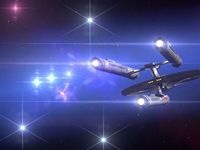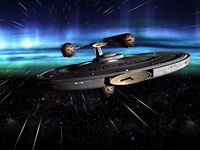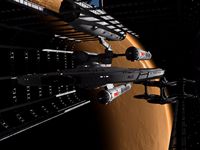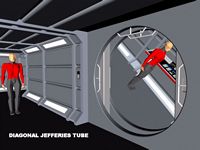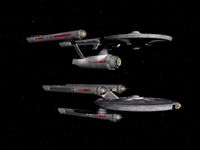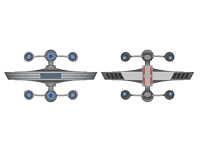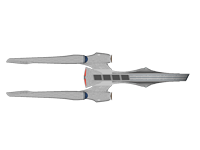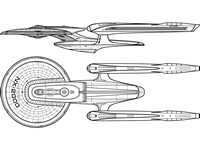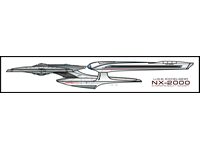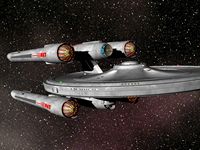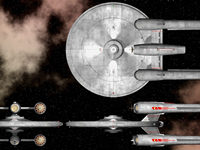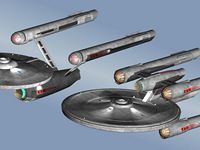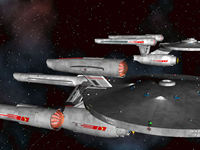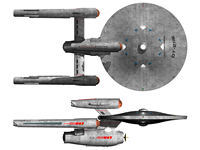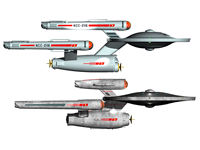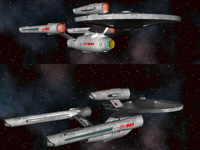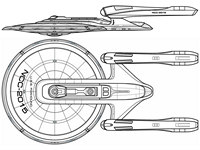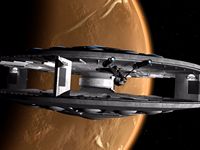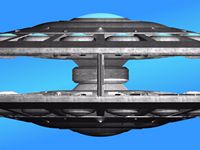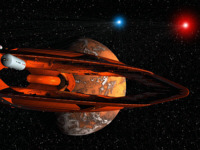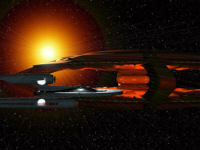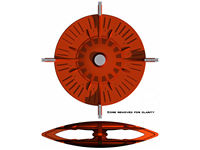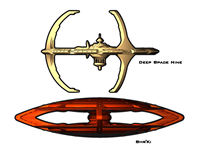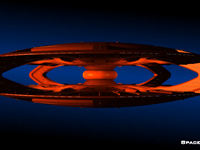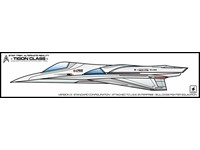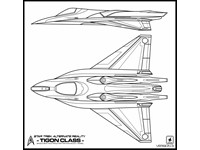Abramsverse Designs
Other Designs, Alien Starships, Future Starships & Design Studies, Abramsverse Designs
Auriga Class
Design by Robert Heckadon
Affiliation: Starfleet (alternate universe)
Type: Experimental galactic exploration cruiser
First commissioned: 2263
Length: 274m
Width: 150m
Height: 68m
Decks: 16
Displacement: 210000t
Complement: 45 officers + 255 crew, evacuation limit: 500
Speed: Warp 5 (cruise), Warp 7 (max.), Warp 7.5 (max. emergency)
Sublight speed: 0.25c (max.)
Armament: 4 phaser banks, 1 forward torpedo launcher
Defense: Cast rodinium defence shields
Embarked craft: 2 warp shuttles, 4 impulse shuttle pods
"One of the best things about leading the Aries expedition is that all you need to do is look up at the constellation and you'll always see us and our ship." - Captain Baysan Nejem, USS Hathaway, 2263.
Called the Charioteer, the Auriga class is an experimental galaxy survey ship that is recognized by its 3 experimental time dilation warp engines. Like her sister class, the Giacchino class, each of the Auriga class is assigned one of the 88 main constellations from Earth's skies and travels to the stars of those constellations. Once in that star system, the ship scans the cosmos from those vantage points and transmits their findings to the Earth Space Probe and Starfleet to coordinate with exploration cruisers for a more detailed investigation.
On the bottom of the saucer just above the lower high resolution sensor array are a series of long range scanners. They scan the cosmos for both radio and subspace radio waves, planets in the goldilocks zone, water, and valuable resources such as dilithium crystals.
The Auriga class uses an experimental time dilation warp drive. By conducting tachyons in the warp coils instead of negative energy, a time dilation effect takes place at warp where time slows like how time slows down on a ship approaching the speed of light using impulse engines. And the higher the warp speeds, the greater the time dilation effect.
At warp factor 1 (1c), the passage of time between the ship and the universe is equal. At Warp 2 (10c) for every second that passes in the ship, 8 seconds pass in the universe. At Warp 3 (39c), 27 seconds in the universe. Warp 4 (102c), 64 seconds, and so forth. This means a trip from Earth to where Vulcan use to be 16 light years away at Warp 5 would still take 27 days to get there, but only 5 hours would pass for the ship and crew.
Critics have said that because the passage of time moves slower on the ship, the power to sustain warp factor 5 would be 125 times greater on the ship just to maintain speed. In reality it's the opposite that's true. Though it appears the ship within the effect is traveling at Warp 14.34, it only needs Warp 5 power to maintain inside the dilation effect, thereby using only 0.8% of the fuel needed for the voyage.
Critics also claim that if the ship were to become trapped at high warp speeds within the time dilation effect, then the crew would be trapped decades if not centuries in the future with no means of returning. In reality starships that can attain Warp 9 cannot maintain that speed for more than 12 hours before overheat and warp field instabilities drops the ship back to impulse. And even then the most into the future the ship would travel to is only one year.
Though real time communications is impossible and other risks with interstellar debris have been addressed, numerous advantages with the new drive include ship fuel and supplies, perishables life expectancy and crew psychology.
One other effect of the time dilation drive is that it seems to disrupt the Lindelof effect. The Lindelof effect is the effect that allows starships to fire phasers at warp when the pursuit ship matches warp velocities with the target ship and is within what is often regarded as suicidal range, typically 50,000km depending on the warp factor.
Starship warp engines generates a subspace displacement field that catastrophically expands space behind the ship's warp field at faster than light speeds that results in the space in front of the ship's warp field to catastrophically collapse at faster than light speeds. The collapsed space then warps around the ship's warp field filling the gap from the expanded space behind the ship which causes the ship's position to shift forward at faster than light speed without inertia.
Using a heavily publicized incident that happened in 2259 to help explain the Lindelof effect, as the USS Enterprise's warp field catastrophically expands the space behind it, the USS Vengeance's warp field catastrophically collapses that same space the Enterprise had just expanded. This then causes the space being collapsed by the Enterprise's warp drive to move past its warp field and handed off to the Vengeance's warp field. The result is a pocket of normal space being formed in between the 2 warp fields and being carried at warp speeds with the 2 ships. And it is within this pocket that allows starships to fire phasers at warp.
Many have mistakenly believed the effect as the collapse and the expansion between the 2 warp fields canceling each other out forming the pocket of normal space.
During a test flight of the time dilation drive to see how the ship would react to pursuit and attack with phasers at 1/100th power, the particle beams began to break up the instant they left the warp field. Though never tested at full power, readings indicated that a full phaser strike would rebound back into the warp field collapsing the field of the attacking ship. But this also renders the time dilation ship's weapons useless.
To compensate for the interstellar debris risk, the Auriga class is equipped with 2 deflector dishes. The saucer mounted dish is a standard navigational deflector while the upper pylon dish is an enhanced tachyon sonar to give the crew in the time dilation effect more time to focus the deflector dish or to make a minute course correction.
The Auriga is armed with 4 phaser and a forward probe launcher that can fire class 8 and 9 probes that have their modular sensor and science equipment packages replaced with cobalt fusion warheads and have their drive systems set to overload and detonate on impact. The shields however are military grade cast rodinium shields.
In each of the dorsal sections and in the quarter aft saucer, the Auriga class has diagonal full ceiling height Jefferies tubes. Deemed an engineering challenge, the graviton wind emitters for artificial gravity are angled with the Jefferies tubes to give the sense of down perpendicular to the tube's deck plate. One side of the tubes has the utility trunks while the other has deck access that can be sealed off in the event of a hull rupture. Even with ease of maintenance and access, the transition from standard decks to the diagonal tubes and back have often described as disorienting.
Rumours have been circulating that the time dilation drive is going to be installed on other exploration cruisers and starships under the Earth Space Probe Program. Though Starfleet hasn't acknowledged this, they did confirm that more Auriga class starships will be constructed with the time dilation drive at the recently commissioned Utopia Planitia shipyard on Mars, to take advantage of the lower gravity, and they will be sent to explore the constellations of Earth.
1 - Does not conform to ILM's official figures
2 - The TNG warp scale is used for Warp 1-9 while the "All Good Things..." warp scale is used for speeds above Warp 9. The TOS warp scale is used for the time dilation effect.
Constellation Class
Design by Terranimperial
Affiliation: Starfleet (alternate universe)
Type: Carrier
First commissioned: 2262
Length: 463m
Width: 221m
Height: 134m
Decks: 38
Complement: 500 officers + 1000 crew
Speed: Warp 7 (cruise), Warp 8 (max.), Warp 9 (max. emergency)
Sublight speed: 0.25c (max.)
Armament: 12 dual emitter phaser banks, 4 forward facing torpedo tubes, 2 aft facing torpedo tubes
Defense: shields
Commissioned ships: USS Constellation NX-1974, USS Stargazer NCC-2893, USS Hathaway NCC-2593
The Constellation class was developed by the heavily militarized Starfleet of the 2260s. The Federation had enjoyed a fragile peace for over a decade, which would be shattered by sightings of Humans on Qo'noS in 2259. With the remnants of the Klingon Empire beginning to strengthen with the help of the Romulan Empire, the Federation began to focus on defense of the Border. Allied Nations freed from the control of the Klingon Empire were also at great risk. After the Fall of the Krios Royal State, it was determined that the Federation could not stand by while their allies in the Beta Quadrant. The Constellation class was drawn up as a multi role transport vessel.
The most notable characteristic of the Constellation class was its unique quadruple nacelle design, with the reason being that in case of a disabled nacelle, the ship would still be capable of maintaining a stable warp field. The nacelles were placed in pairs on each of the secondary hulls. The Constellation class had the unique ability of being able to launch its modified HGX-01 Nacelles as warheads.
The primary hull featured 8 hangar bays, with 4 lined in a row along each side. The hangar space could be used in various ways. Constellation class ships carried fighter ships and other small vessels to and from the frontlines. They also ferried supplies to friendly worlds. In cases where an evacuation was needed, A constellation class vessel could utilize the transporters in it's hangars, to mass transport people and objects aboard. 2 impulse engine units were located on the aft of the primary hull, on the 'nape' of the two neck pylons. The Impulse engines were sometimes placed farther apart on refitted vessels for increased maneuverability at sub-light speeds.
Constellation class vessels were somewhat of a departure from previous Starfleet designs (while the Newton Type could be used as a carrier, it was not solely dedicated to said role). The versatility of the constellation class would allow it to continue in service for over a century. During times of peace, these vessels were relegated to disaster relief efforts and transport duties.
A Kelvin timeline version of the Constellation Class. It uses components of the Abramsverse Enterprise-A designed by Sean Hargreaves
Excelsior Class (alt.)
Design by Jetfreak
Affiliation: Starfleet (alternate universe)
Type: Explorer and battleship
First commissioned: 2265
Length: 950m
Complement: 80 officers + 1024 crew, evacuation limit: 3500
Speed: Warp 6 (cruise), Warp 8.75 (max.), Warp 8.9 (max. emergency)
Armament: Phaser banks and photon torpedoes
Defense: Deflector shields, ECM and basic hull armor
Embarked craft: Shuttlecraft, Work Bees, Tigon Fighter/Scout (optional)
Designed as a larger counterpart to the already capable Constitution, the Excelsior Class is an advanced and versatile starship, capable of almost any role. While some of details of the vessel are known, most of it is still classified by Starfleet. The Excelsior is currently under the jurisdiction and control of "Project Arrowhead". Which is supposedly conducting research on advanced propulsion technologies. Speculation is centered that the Excelsior may be utilized as a testbed for new technologies. She is currently docked at Earth Spacedock as of 2265. Undergoing a major overhaul of the engineering section.
The AR Excelsior sports a "hot rod" and streamlined forward facing look akin to the AR Constitution, creating a relation between the two designs.
The nacelle design has undergone several tweaks and the struts have been completely redesigned to match the Enterprise's forward swept versions. Furthermore, I wanted to retain the nacelle cap aesthetic since she had been launched at an earlier date. The nacelle "wings" raise up at warp like her smaller sibling and the grilles also glow blue at warp. It gives the nacelles more functionality and movement.
Comparing it with side views of the original, my new design takes some cues from the original and mixes some stylized elements from the new Enterprise. Showing that the two are related in terms of technicalities and aesthetics, just like the originals.
As seen here, she is scaled at exactly 950 meters at length, keeping in line with the "official" ILM figures. (The Enterprise was 725m long). Also provided in the finalized view are the Tigon and the new Shuttlecraft, to give a further sense of scale.
Thanks to Gus, whose work on the prime Excelsior served as the basis for this illustration.
Giacchino Class
Design by Robert Heckadon
Affiliation: Starfleet (alternate universe)
Type: Deep survey cruiser
First commissioned: 2259
Length: 261m
Width: 151m
Height: 72m
Decks: 24
Displacement: 1100000t
Complement: 40 officers + 310 crew, evacuation limit: 1000
Speed: Warp 7.5 (cruise), Warp 8 (max.), Warp 8.5 (max. emergency)
Sublight speed: 0.25c (max.)
Armament: 2 dual bank, 120 megawatt PHASed Energy Rectified particle canons (AKA phasers); 4 dual bank 80 megawatt, 120 megavolt phased modulated electron particle discharge pulse canons (AKA laser pulse canons)
Defense: Magnetic flux consolidation force shields; polarized hull plating
Embarked craft: 4 standard shuttlecrafts
"Giving someone else equal rights does not infringe or take away right from you. It just makes it illegal to enforce your prejudice and hate. It's that simple." - Stephen Bryce, 2012
With the vastness of space, it would take a single Starfleet vessel more than 12,000 years to explore every single solar system in the Milky Way galaxy alone if the ship stayed in the solar system for only 1 second and instantly travelled to the next solar system. To maximize resources, Starfleet commissioned the Giacchino class deep survey cruiser.
The Giacchino class is designed to travel through space and scans the cosmos at different vantage points with incredible detail with the use of its long range astronomical sensors, and send its findings to Starfleet Command and Earth Space Probe who then sends a ship for a more detailed analysis. The heavy survey cruiser's course takes it to the major stars that make up the greater constellations in Earth's sky. These include Betelgeuse, Bellatrix and Rigel in the constellation of Orion.
The Giacchino class is recognized by its quad-nacelle design, upper engineering hull, and lower shuttle hull. Despite conventional wisdom, the warp capability of a ship is not dependent on the number of nacelles the ship has, but the frequency oscillation of the negative energy within the warp coils. This means that despite fact that the Giacchino class has 4 nacelles, it is no faster than a Constitution class starship which only has 2 nacelles, or an Einstein class* with a single nacelle. The use of the quad nacelle design is for what is referred to as warp field handoff. This allows the ship to transfer the warp field from one pair of nacelles to another and give time to run a level 3 diagnostic on the first set of warp engines, to recycle the excess thermal energy and to recharge without having to drop out of warp.
During the warp field handoff, power to the deflector dish increases by 25%. When the warp field catastrophically collapses the space in front of the ship, it ionizes the interstellar gases and dust that allows a focused magnetic beam from the deflector to passively clear a path of these ionized obstacles with a 900 megavolt "antiproton" particle beam to clear the path of meteors greater than 1kg. But during warp field handoff, there is a brief disruption in the magnetic beam that could allow some space dust to punch a hole in the hull the size of an average adult fist. And thus the disruption is compensated by the increase in power.
The Giacchino class is armed with 2 offensive phaser canons and 4 defensive laser pulse canons. Many tacticians were upset when the port laser canons were fed by one transformer and the starboard laser canons were fed by another. In the event one laser transformers overloads, the entire laser assembly on the one side shuts down. The cruiser normally does not carry photon torpedoes, however depending on the mission the fore and aft probe launchers are capable of launching photon torpedoes and many of the class 8 and 9 probes that are carried on the Giacchino class can be fitted with dicobalt warheads.
Since many energy weapons are plasma based, ion based or have some form of electrical charge to them, the Giacchino class uses a magnetic flux consolidation force shield that with the use of a subspace amplifier, consolidates the magnetic flux lines to repel the particle weapons. And since the shields generate a virtual solid barrier, it is enough to detonate most projectile weapons that are programmed to detonate on impact. And despite conventional wisdom, nuclear weapons have very little effect on a spaceborne target since the real damage comes from the shockwave of the blast rather than the blast itself unless it's heavy plasma based or dicobalt based weapon, or the nuclear blast accelerates projectiles from the detonation.
The designers had hoped that the shuttle hull would incorporate a thru-deck shuttle bay with fore and aft doors. But the idea was abandoned because of the need for a simple design for the warp power conduits to the lower warp drive and for the turbolifts. Critics have asked why not place the shuttle hull on the top where there would be room for a thru-deck shuttle bay concept? The umbilical connection port on the top of the ship would still get in the way of the concept.
To ensure room for 2 warp cores and antimatter supply in the engineering hull, the primary deuterium fuel supply is located in the saucer section and the ship's primary thermoelectric generators are placed in the warp nacelle pylons to serve the dual purpose of recycling the engine thermal waste and the ship's general thermal energy buildup, and venting excess heat.
Though a combat effective ship, the Giacchino class is deemed a non-military vessel and thereby no MACOs are stationed on board. However after the destruction of Vulcan, they mysterious ship crashing into San Francisco and the murder of Admiral Pike by the terrorist only known as John Harrison, there are rumours flying that the Giacchino may soon have MACOs on board and being armed with photon torpedoes. But no one is ready to comment.
*The accepted class of the USS Kelvin.
**The ship does not conform to "official" ILM figures.
Gilgamesh Class
Design by Robert Heckadon
Affiliation: Starfleet (alternate universe)
Type: Dreadnought
First commissioned: 2258
Length: 309m
Width: 157m
Height: 87m
Decks: 30
Displacement: 1700000t
Complement: 72 officers + 428 crew, evacuation limit: 1000
Speed: Warp 6 (cruise), Warp 8 (max.), Warp 9.4 (max. emergency)
Sublight speed: 0.15c (max.)
Armament: 16 phasers, 4 photon torpedo launchers
Defense: Cast rodinium shields, polarized hull plating
Embarked craft: MACO hoppers
"If we die, then we were born to die this day." - Kahless the Unforgettable
In 2233 while escorting 600 colonists through the neutral zone en route to Tarsus 4, the USS Kelvin was attacked and subsequently destroyed by an unknown starship, of incredible size and formidable weapons, that emerged from what could only be described as a lightning storm in space that the Kelvin was investigating.
An analysis of the Kelvin's sensor logs and records that were downloaded to the escape shuttles indicates that the attackers were Romulan. This was based upon evidence such as the ship's warp signature, reverse linguacode translation, and traces of a molecular decay detonator on the hull of medical shuttle 37. The discovery of the Romulans altered Starfleet's priorities which subsequently lead to a decade long delay of the Constitution class exploration cruiser in favour of the development of the Gilgamesh class dreadnought.
Often being called a Constitution class on Venus drugs**, the Gilgamesh class dreadnought was designed to respond to any aggression against the Federation. However since the mysterious Romulan ship that attacked the Kelvin has neither been seen nor heard in over 3 years, construction of the dreadnought didn't begin until 2258 following the destruction of the Vulcan. And even after the mysterious ship was reportedly destroyed the USS Enterprise under the command of the ship's acting captain, Lt. James T. Kirk, Starfleet didn't want a repeat of the Vulcan incident.
The Gilgamesh is armed with 16 phasers, 2 banks each, 4 photon torpedo launchers, dicobalt ordinance and what is simply referred to as "special ordinance." The ship's maximum warp speed is about 15% greater than the Constitution class's maximum rated speed. The phasers are also designed to fire in steady stream or pulse beams, but only have a kill setting. The ship is capable of transporting nearly 1000 MACOs to a planet requiring their services.
Though the Gilgamesh class is a Starfleet vessel, which is a branch of the armed forces like the MACOs, the dreadnought and other designated tactical vessels (DT-XXXX)*** are not under the command of the Earth Space Probe, the Bureau of Colonization, nor any other non-military organization and takes orders directly from Starfleet and the Federation Defence Directorate, which stirred up significant controversy of making a Starfleet vessel a pure military ship.
Originally, the dreadnought was designed to have a tertiary nacelle on top of the saucer section in an effort to give the ship a maximum speed of warp factor 10. However practicality and tactical reasons placed a tertiary hull on top of the saucer instead. This section contains the ship's secondary warp core and its own antimatter fuel which is used to power the ship's weapons, shields and tactical systems. This then allows the ship's primary warp core in the secondary hull to concentrate its power for warp drive and primary systems. As well in the event of primary warp core failure, the ship can still remain an effective combat ship. Due to the robust nature of the dreadnought, the power of the 2 warp cores do not cross connect.
The tertiary hull also contains the fore and aft photon torpedo launchers. In extreme circumstances the tertiary hull can separate and be used as a missile and detonate its warp core and remaining ordinance at the enemy. In the event of emergency hull separation, the ramscoop on the tertiary hull collects high energy plasma from a nearby star to augment the saucer's energy reserves until a rescue ship can arrive.
Critics have often called the tertiary hull as the ship's power top. This term originated in the early 22nd century when skyscrapers use to carry wind turbines on the top 5-10 floors to generate power within its open structure. However a few corporations have placed executive offices and suites over the turbine floors to somehow symbolically be atop unlimited power.
It was considered to channel power directly from the secondary warp core into the ship's phaser banks. Unfortunately the charge from the secondary warp core is too high for the phasers to safely harness directly. As a result, 8 high energy sarium fuel cells are used power the phasers directly, and the warp power is used to rapidly recycle the spent sarium reactants in a high output recharging coil. This also gives an added tactical advantage by giving nearly 1 minute of full phaser power should the secondary warp core be rendered unavailable.
Due to the amount of bulk added to the ship, 2 impulse engine units were designed to draw power directly from the secondary warp core at a matter/antimatter ratio of 40:1 to maintain pace with the Constitution class.
The dreadnought has had its fair share of rumours. Many of these include:
- The ship was built with die cast construction.
- The ship produces food using transporter duplication.
- The ship is controlled by an artificial intelligence with an android avatar*.
- Energy from the sudden compression of the interstellar gases at warp is collected by the ramscoops to power the warp drive.
- The ship is driven by an "antigravity" warp drive.
Though many rumours were easily dismissible, 2 rumours have been troublesome for not only conspiracy theorists, but for debunkers as well.
- The ship is equipped with some form of "transwarp transporter" whose range is measured in AUs rather than hundreds of kilometres.
- The ship's "special ordinances" are actually the missiles fired from the massive Romulan ship in Earth orbit and captured by Starfleet.
What made it more troublesome is that the investigation to simply debunk such claims was halted by Starfleet charter - article 14, section 31.
* Based upon Gene Roddenberry's Andromeda
** "Mudd's Women"
*** http://www.shipschematics.net/startrek/faq.php
Does not conform to "official" ILM figures.
Hurricane Class
Design by Jetfreak
Affiliation: Starfleet (alternate universe)
Type: Destroyer
First commissioned: 2260
Length: 530m
Speed: Warp 6 (cruise), Warp 9 (max.)
Armament: Phasers, photon torpedoes
Defense: Deflector shields, ECM and basic hull armor
The Hurricane-class destroyer was created in response to a Starfleet requirement for a modern and adaptable destroyer sized vessel. The project was created due a recent combat evaluation of existing types in current service. Most were apparently aging and were largely outdated designs which needed replacement as soon as possible. The success of the Constitution-class project assisted in the development of the Hurricane. The new design incorporated many design elements from the latter in many ways. Which includes the streamlining of the hull, the powerful propulsion system and advanced weaponry. As such, both classes complement each other rather well, due to many similarities in operating systems and internal hardware commonality.
With outstanding results in tests and trial runs, the future of the Hurricane class sounds promising. Starfleet has already commissioned Utopia Planitia to begin immediate construction of the type to bolster the destroyer fleet. Over fifty are planned for the first batch alone and the first six LRIP vessels have already entered service. The Hurricane, Bagabaldo, Typhoon, Cobalt, Foxhound and Alcyone. The Foxhound herself is currently attached to the Cobra Destroyer Wing of the Federation First Fleet, which provides constant area defense for the Sol Sector.
Illustrated above is an alternate reality destroyer that I've been developing for quite a while now. Called the Hurricane Class, this one is represented by the USS Foxhound NCC-2015.
She may be quite smaller than the Constitution, but she packs a powerful punch as well. As seen here, her hull configuration takes some very obvious cues from the NX Class. Which served as the basis for much of the general appearance.
In terms of design aspects, the Hurricane is pretty much the Constitution's smaller sibling. Both in aesthetics and technicalities The shape of the nacelles, the hull coloring and overall general appearance are indeed inspired by the latter. It also creates a much needed relation between the two designs, adding to Hurricane's believability.
Another point of interest is the design's own uniqueness in itself. One of the goals in this project is to not create another kitbash using Constitution parts. The Hurricane utilizes unique parts and components of its own but her relation to the Constitution is still recognizable nonetheless. She is also a very rugged vessel, hence the apparent thickness of the nacelle struts and compact nacelles.
Using the bridge module, (based on the AR Enterprise) as a basis for the vessel's scale, she would be roughly 530 meters in length using the ILM figures.
Sheridan Class
Design by Robert Heckadon
Affiliation: Starfleet (alternate universe)
Type: deep space outpost
First commissioned: 2262
Length: 1256m
Width: 1256m
Height: 457m
Decks: 155
Displacement: 109000000t
Complement: 190 officers + 2100 crew, evacuation limit: 6200
Sublight speed: 0.001c (max.)
Armament: 32 - 110 MW phased energy rectified particle canons (AKA phasers); 16 - 90 MW, 200 MV phase modulated electron particle beam point defence particle canons; 4 photon torpedo launchers with various warheads.
Defense: 200 MW cast rodinium defence shields; SIF enhanced hull plating and defence fields.
Embarked craft: 110 personal shuttle craft, 40 cargo shuttles, 100 Tigon class fighters
"There will always be those who mean to do us harm. To stop them, we risk awakening the same evil within ourselves." - Captain James T. Kirk, 2260
Despite the growing tensions between the Federation and the Klingons in 2259, many in Starfleet were adamant in the Earth Space Probe program and that they wanted to start it as early as 2260 to begin a 5 year mission to explore uncharted space. Even after the bombing in London, the attack on Starfleet headquarters and the devastation in San Francisco, the program began with the rechristened USS Enterprise as the first ship to begin the program. And with other ships soon to venture into unexplored territory, a command base would be needed thus introducing the Sheridan class starbase.
Basing their design loosely off of the now abandoned Vulcan space station, Shr'Ki, the Sheridan class is recognized by the upper and lower saucer design with 16 conservatory structures and central park dome on the upper saucer and the 16 helium-3 and deuterium fuel bins on the lower saucer.
The station is equipped with 16 shuttle bays and can support and repair eight starships at once with the docking support facilities on the underside of the upper saucer. The lower saucer's docking ports are mostly dedicated for cargo and transport containers, fuel transports including antimatter and raw material transports.
The operations centre and executive docking ports are located in the central core above the engineering compartment.
Though its mission is peaceful, the Sheridan class is armed with 32 high yield phaser turrets, 16 point defense laser canons, and 4 photon torpedo launchers that can also fire various warheads including dicobalt warheads.
The station is defended by a high output cast rodinium shields. It was considered giving the station plasma armour as a backup to the cast rodinium shields. Plasma armour is an obsolete defense barrier that was in common use by many non-terrestrial species first encountered by the NX-01 Enterprise in the mid 22nd century.
It involves bringing magnetic field sources from radiation shields and navigational deflectors to full power. A series of subspace amplifiers then consolidates the flux lines of the magnetic fields into a magnet barrier a few millimeters thick. Plasma that's phase synchronized with the consolidated magnetic field via subspace amplifiers is then injected into the field and conducts the flux lines forming a solid yet invisible barrier. The barrier would then break up particle weapons and prematurely detonate torpedoes so the station would withstand them better.
Several drawbacks to the plasma armour prohibited it as a secondary defense:
- The size of the station
- Twice the power for half the protection
- The shield needs to be open to fire phasers and torpedoes
- Any significant hit would disperse the armour leaving that section of the station vulnerable
- The shield is vulnerable to antiproton attacks, especially photon torpedoes.
This eventually lead to polarized hull plating being a more viable secondary defense with new developments in SIF generators and energy absorption matrices. The term "plasma armour" was derived from the 20th century space opera Galaxy Quest which historians believed inspired Captain WM Jefferies when constructing the NX-01 Enterprise.
The space station is powered by 12 helium-3 cold fusion reactors. A dilithium crystal at the centre of each reactor reduces the ignition temperature of helium-3 and deuterium from 400 million Kelvin to less than a quarter million Kelvin. Due to the low ignition temperature and the plasma focusing nature of dilithium, each reactor can process enough fuel to release the power equivalent of an antimatter reactor at great fuel costs. Specifically when compared to a 3 year antimatter fuel supply, an equal mass of helium-3 would be exhausted in approximately 12 hours at same power generation rates.
The station's 16 fuel bins on the lower saucer have 10 are filled with slush cryogenic deuterium and 6 are filled with slush cryogenic helium-3. Since the station only requires an average of 1kg of helium-3 fuel a day, the rest is dedicated to civilian and short range warp ships that also use helium-3 and dilithium for their warp drive. Antimatter and neutronic fuel are stored in external transport containers docked with the station so they can undocked and blasted away from the station in the event of a catastrophic emergency.
The station's hydroponic gardens and parks uses porous bio-nutrient aerogel which us also used on starships. This forms a soil layer allowing roots to grow unimpeded while giving a solid surface to walk on. Holes in the aerogel allow nutrient enriched water recycled from the sanitary recovery systems to reach the plant's roots. This also allows for the plants to remain in their position in the event of IDF failure, gravity orientation being knocked off axis (1), or total gravitational axis/orientation control loss (2). Many of the gardens, orchards and tissue engineered meats are used as a base pattern for protein resequencers on starships, while also like on starships using chemosynthetic bioprocessors for the biomass material.
One of the more complicated and expensive part of the station are the station's 17 domes. Each transparent aluminum dome has a coating of neo-reflectors that passively angles sunlight down into the parks regardless of the angle the light is coming in barring obstacles such as station and planetary bodies.
The station carries transporter based industrial replicator units for starship repair and maintenance.
Starships larger than a scout class uses fabricators that are comparable to 3D printers of the 21st century. A series of phase ionization processors delivers the materials for both alloy generation and printing. These can range from steel and plastic pipes, tritanium hull plates, even duotronic circuit board plates.
Whereas starship fabricators can take as much as 20 minutes to print the carbon nanotubes and tri-silicate aerogel in a corrugated pattern for a single hull plate, the replicators on the station can make the same hull plating in a matter of seconds.
Though requiring 15% less energy, the power of the replicator units would overload many circuits on even Constitution class starships. As well the replicator pattern buffer is nearly 30 metres in diameter and very fragile making them currently unfeasible to install on starships at this time.
Neither fabricator nor replicator is capable of generating organic material outside of rubber and plastic material.
Despite the peaceful mission, there are still those in Starfleet who agree with the late Alexander Marcus with Starfleet needing to take a more military stance and wish the Sheridan class to reflect that. Despite the claims the space station's armament rating and defensive capabilities, as well as strategic locations were already set up in the event of hostile forces coming from the unknown like the Xindi incident over a century ago.
In 2262, the first Sheridan class was commissioned and designated Deep Space Four with 2 more under construction.
(1) As seen from the first attack on the Enterprise on the Doomsday Machine, and the Reliant's first attack in the Enterprise in The Wrath Of Khan.
(2) As seen on Star Trek Into Darkness.
Does not conform to official ILM figures.
Shr'Ki Class
Design by Robert Heckadon
Affiliation: Vulcan (alternate universe)
Type: Space port/ore refinery
First commissioned: 2237
Length: 1572m
Width: 1572m
Height: 360m
Decks: 127
Displacement: 117000000t
Complement: 220 officers + 1820 crew, evacuation limit: 6500
Sublight speed: 0.001c (max.)
Armament: 8 - 72 megawatt, 88 megavolt phase modulated electron particle beam discharge canons (AKA lasers); 8 - 38 megawatt phase modulated energy discharge canons (AKA phase canons).
Defense: 50 megawatt magnetic force shields
Embarked craft: 100 personal shuttle, 45 cargo shuttles, 50 fighters
"Emotions run deep within our race, in many ways more deeply than in humans. Logic offers us serenity humans seldom experience. The control of feelings, so they do not control you." - Ambassador Sarek, 2242*
Called the Watcher, the planet T'Khut is a menacing site in the Vulcan sky. Nicknamed Charis in 2067, and later Delta Vega in 2249, T'Khut and Vulcan orbit each other with a common centre point in the 40 Eridani star system. And in this centre point is the Shr'Ki space port.
Commissioned in the Earth year of 2237, the Shr-Ki space station is a combination of a trading outpost and an ore refinery. The upper saucer measuring over 1200 metres in diameter is the habitat section that houses more than 2000 Vulcans and other humanoid life forms. The lower saucer is the refinery and storage for the ore mined from Delta Vega, which includes boridium, rubindium, and trillium.
The bottom of the upper saucer and the top of the lower saucer contains the station's 16 shuttle bays, cooling systems, and 32 docking facilities for the standard Federation transport containers. The 2 saucers are connected on the outer parts of the station by 4 docking arm complexes. Each arm carries 14 docking ports with observation galleries and 4 airlocks for the station's maintenance bots.
The centre of the space port that separates the 2 saucers is simply referred to as the core. The core is simply the command and control section of the space station, which also includes diplomatic conference rooms for visiting ambassadors within the Federation. Above the core is the station's fabrication and non-organic recycling systems, and below are the station's power generators. During the last year of construction and first year of operation, rumours circulated that the core was an experimental power generator that used a type of folded-space transport, later to be known as the Elway Theorem, to dimensionally shifting the raw solar energy from 40 Eridani A into the station's dilithium chamber. That rumour was proven to be false since the station is powered by neutronic fuel.
Located at the 115 position on the periodic table, neutronic fuel is a stable isotope that when it is bombarded by high energy protons, the isotope transforms into element 116, which is highly unstable. 2 neutrons in each atom of neutronic fuel undergo a type of beta decay, releasing a positron transforming the 2 neutrons into antiprotons. The newly formed antiprotons then react with 2 protons within the isotope in an annihilation reaction, with secondary energy released through fission for when the neutronic fuel atoms disintegrate.
Due to the enormous size of the space station, the station's thrusters are fusion thrust engines similar to the impulse engines used on starships, but fuelled by helium-3/deuterium reaction. If the station used the thruster systems found on starships, by venting the plasma from impulse fusion reactors to the thrusters via EPS power grid, it would cause both an unsafe drop in the station's power usage and the power load in the power grid would reach dangerous levels.
The standard duty uniforms are grey/blue, beige or white duty tunics with colour matching trousers, belt, boots, a black undershirt, and the rank located on the shoulders. ***
Since Shr'Ki is not a military outpost, it does not contain military grade weapons and defences. The station is armed with 8 weapon ports. Each port is armed with a 72 megawatt laser canon as the primary weapon with a 38 megawatt phase canon to supplement the lasers, especially during the laser's recharging cycle. The station is defended by a 50 megawatt magnetic force shield that, with the use of a subspace amplifier, consolidates the magnetic flux lines into a "solid" barrier.
Critics have asked since the station is a vital trading outpost and ore refinery, why doesn't the station have more sophisticated weapons? The logic behind this decision is based upon the facts that Shr-Ki is a civilian station and deep within Federation territory, calculating the probability of a successful assault on the space station at 98,451 to 1.
Rather than using a vast network of air ducts to transfer carbon dioxide and oxygen between the station and its life support systems, which requires its own emergency bulkheads, the station uses an experimental "circulatory system" to transfer the gases to and from the airtight compartments.
Each airtight compartment uses traditional ductwork to circulate the atmosphere within it, and for the atmosphere to pass through an atmospheric processor. The processor begins by collecting carbon dioxide in an aqueous calcium carbonate solution, using a dichromate additive to allow the limestone to be soluble in water, and transfers the newly formed calcium bicarbonate solution under pressure to the station's hydroponic gardens and chemosynthetic bioprocessors.
Oxygen is delivered to the processors using a liquid oxygen compound simply known as oxygen-17. Oxygen-17 is generated in life support using verteron radiation, and is reverted back to O2with phase modulated gamma rays generated in the atmosphere processor.
This system allows the station to be more rigid and safer in the event of a catastrophic atmospheric pressure loss, requiring only simple gate valves rather than full scale bulkheads. Though the carbon dioxide removal system has become standard, the equipment to generate oxygen-17 is deemed too bulky and fragile on starships and space stations below a certain size class and requires conventional oxygen supply ducting and air vents.
Engineers from Earth have asked why there is no condensing coil in the atmospheric processor to collect water vapour from respiration and linked to the sanitary recovery lines? Aside from Vulcan lung structure being similar to Earth avians, they also have glands to retain water during respiration, allowing them to go without water for days.
In 2258, Shr'Ki was given the most important duty of its entire existence when it became the temporary refuge of the 10000 Vulcan survivors when their planet was destroyed by a mysterious Romulan force. A few days later, a mysterious elder Vulcan calling himself Selek** found a suitable planet to establish a Vulcan colony for the survivors.
* Based upon Jacob Kogan's age of 12 prior to March 27th, 2008 when principle photography of Star Trek (2009) wrapped up, and according to
www.memory-alpha.org, Spock was born in 2230.
** From the animated series episode "Yesteryear."
*** Similar to the Motion Picture uniforms, only less dorky.
Tigon Class
Design by Jetfreak
Affiliation: Starfleet (alternate universe)
Type: Multirole fighter and scout vessel
First commissioned: 2260
Length: 21m
Width: 16.58m
Height: 3.45m
Complement: 1 officer
Speed: Warp 3 (cruise), Warp 4.5 (max.), Warp 4.8 (max. emergency)
Armament: Phaser cannons and photon missiles
Defense: Deflector shield and ECM suite
A Starfleet fighter craft and scout vessel, the Tigon Class was developed around the same time as the Constitution Class. As such, both vessels share several design elements such as nacelle design, control interfaces, hull plating and weapon systems.
Though initially designed to be carried aboard starbases, an average starship can also be modified to carry several Tigons for general and tactical support purposes. Tigons are organized as fighter squadrons of up to twelve fighters and are tasked with a variety of roles such as scouting and combat support. Pilots wear a special flight suit with a built in life support system and distress beacon.
Armament includes two phaser cannons mounted on both sides of the main fuselage and twelve long range photon missiles stored in a weapon bay. Defense includes a single layer deflector shield system and a short range jamming suite.
The type has no Prime Universe counterpart. Apparently, the Kelvin incident of 2233 pushed Starfleet to give fighter designs more support. The ineffectiveness of traditional shuttles in the tactical support and scouting role was apparent.

